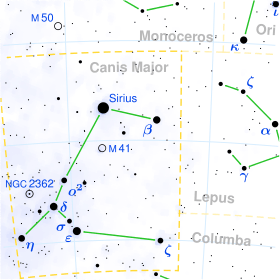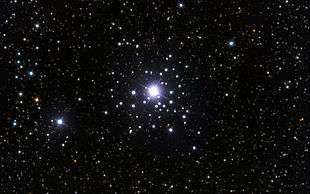Tau Canis Majoris

| |
| Observation data Epoch J2000 Equinox J2000 | |
|---|---|
| Constellation | Canis Major |
| Right ascension | 07h 18m 42.48642s[1] |
| Declination | −24° 57′ 15.7413″[1] |
| Apparent magnitude (V) | 4.40[2] (4.89 + 5.33 + 9.70[3]) |
| Characteristics | |
| Spectral type | O9II[4] (O9II + B0.5V + B0.5V[5]) |
| U−B color index | −0.99[2] |
| B−V color index | −0.15[2] |
| Variable type | β Lyr[6] |
| Astrometry | |
| Radial velocity (Rv) | +33.80[7] km/s |
| Proper motion (μ) | RA: −2.31[1] mas/yr Dec.: 5.02[1] mas/yr |
| Parallax (π) | 1.09 ± 0.59[1] mas |
| Distance | 1,570[8] pc |
| Absolute magnitude (MV) | −5.9 + −3.6 + −3.6[5] |
| Details | |
| τ CMa Aa | |
| Mass | 50[9] M☉ |
| Radius | 19.8[10] R☉ |
| Luminosity | 280,000[11] L☉ |
| Surface gravity (log g) | 3.5[10] cgs |
| Temperature | 32,000[11] K |
| τ CMa Ab1 | |
| Mass | 17.8[9] M☉ |
| τ CMa Ab2 | |
| Mass | 17.8[9] M☉ |
| Other designations | |
| Database references | |
| SIMBAD | data |
Tau Canis Majoris (τ CMa, τ Canis Majoris, 30 CMa) is a multiple star system in the constellation Canis Major. It is approximately 5,000 light years distant and is the brightest member of the open cluster NGC 2362.
System

Credit: Adam Block/Mount Lemmon SkyCenter/University of Arizona
τ Canis Majoris lies at the center of the very young open cluster NGC 2362 which contains several hundred stars. It is by far the brightest member of the cluster and the only one to have evolved away from the main sequence. A number of stars were catalogued by John Herschel as companions: component B is a 10th magnitude star 8.6 arc-seconds distant; component C is a 14th magnitude star 14.2 arc-seconds away; and component D is an 8th magnitude star at 85 arc-seconds.[3][12] These stars are all thought to be main sequence members of NGC 2362. A period of 94,000 years has been suggested for the AB pair assuming they are gravitationally bound.[13]
In 1951, component A was resolved into a double separated by only 0.15", with an estimated orbital period of 250 years.[14] The Washington Double Star catalogue lists the pair as magnitude 4.89 Aa and magnitude 5.33 Ab,[3] but the CCDM designates the components as A and P.[15] A 10th magnitude component E was discovered in 2010. It is less than 1" away from the 4th magnitude main component.[16]
The primary component A is itself a spectroscopic binary with a period of 154.918 days. The variable radial velocity was discovered in 1906 and the first orbit published in 1928.[17] More recently, the Hipparcos satellite data revealed the existence of a 1.282 day eclipsing binary within the system, with two equal minima where the brightness dips by half a magnitude.[5] The short period eclipsing pair is the fainter component of the two longer period spectroscopic binary, forming an unusual triple star with the most massive component orbiting pair of smaller stars.[9] These three stars are referred to as Aa, Ab1, and Ab2, not to be confused with the fainter visible star 0.15 arc-seconds distant.[15]
UW Canis Majoris is another 4th magnitude star less than half a degree away, and is itself an eclipsing binary system associated with NGC 2362. It has been catalogued as τ2 CMa, but that name is now rarely used.[18]
Properties
τ Canis Majoris appears as a class O supergiant at a distance of 5,000 light years within the open cluster NGC 2362, but this is composed of multiple stars. The properties of the minor components of the τ CMa system are poorly known. Component D has been described as having spectral type B2V, but this is uncertain.[13] The relative brightnesses of the three spectroscopic components have been calculated from the eclipses and orbital movement. The spectrum, mass, and luminosity is dominated by component Aa which is now considered to be an O9 bright giant. It is thought to have a mass around 50 M☉, a temperature of 32,000 K, and a luminosity of 280,000 L☉. The two eclipsing stars are almost identical class B main sequence stars with masses around 18 M☉.
This star is sometimes known as the 'Mexican Jumping Star' by amateur astronomers, because it can appear to 'jump around' with respect to the other stars in the cluster because of its marked contrast in brightness.[19]
References
- 1 2 3 4 5 Van Leeuwen, F. (2007). "Validation of the new Hipparcos reduction". Astronomy and Astrophysics. 474 (2): 653. arXiv:0708.1752
 . Bibcode:2007A&A...474..653V. doi:10.1051/0004-6361:20078357.
. Bibcode:2007A&A...474..653V. doi:10.1051/0004-6361:20078357. - 1 2 3 Ducati, J. R. (2002). "VizieR Online Data Catalog: Catalogue of Stellar Photometry in Johnson's 11-color system". CDS/ADC Collection of Electronic Catalogues. 2237. Bibcode:2002yCat.2237....0D.
- 1 2 3 Mason, Brian D.; Wycoff, Gary L.; Hartkopf, William I.; Douglass, Geoffrey G.; Worley, Charles E. (2001). "The 2001 US Naval Observatory Double Star CD-ROM. I. The Washington Double Star Catalog". The Astronomical Journal. 122 (6): 3466. Bibcode:2001AJ....122.3466M. doi:10.1086/323920.
- ↑ Sota, A.; Maíz Apellániz, J.; Morrell, N. I.; Barbá, R. H.; Walborn, N. R.; Gamen, R. C.; Arias, J. I.; Alfaro, E. J. (2014). "The Galactic O-Star Spectroscopic Survey (GOSSS). II. Bright Southern Stars". The Astrophysical Journal Supplement. 211: 10. arXiv:1312.6222
 . Bibcode:2014ApJS..211...10S. doi:10.1088/0067-0049/211/1/10.
. Bibcode:2014ApJS..211...10S. doi:10.1088/0067-0049/211/1/10. - 1 2 3 Stickland, D. J.; Lloyd, C.; Sweet, I. (1998). "Spectroscopic binary orbits from ultraviolet radial velocities. Paper 27: Tau Canis Majoris (HD 57061)". The Observatory. 118: 7. Bibcode:1998Obs...118....7S.
- ↑ Samus, N. N.; Durlevich, O. V.; et al. (2009). "VizieR Online Data Catalog: General Catalogue of Variable Stars (Samus+ 2007-2013)". VizieR On-line Data Catalog: B/gcvs. Originally published in: 2009yCat....102025S. 1. Bibcode:2009yCat....102025S.
- ↑ Pourbaix, D.; Tokovinin, A. A.; Batten, A. H.; Fekel, F. C.; Hartkopf, W. I.; Levato, H.; Morrell, N. I.; Torres, G.; Udry, S. (2004). "SB9: The ninth catalogue of spectroscopic binary orbits". Astronomy and Astrophysics. 424 (2): 727. arXiv:astro-ph/0406573
 . Bibcode:2004A&A...424..727P. doi:10.1051/0004-6361:20041213.
. Bibcode:2004A&A...424..727P. doi:10.1051/0004-6361:20041213. - ↑ Gudennavar, S. B.; Bubbly, S. G.; Preethi, K.; Murthy, Jayant (2012). "A Compilation of Interstellar Column Densities". The Astrophysical Journal Supplement. 199: 8. Bibcode:2012ApJS..199....8G. doi:10.1088/0067-0049/199/1/8.
- 1 2 3 4 De Vries, N.; Portegies Zwart, S.; Figueira, J. (2014). "The evolution of triples with a Roche lobe filling outer star". Monthly Notices of the Royal Astronomical Society. 438 (3): 1909. arXiv:1309.1475
 . Bibcode:2014MNRAS.438.1909D. doi:10.1093/mnras/stt1688.
. Bibcode:2014MNRAS.438.1909D. doi:10.1093/mnras/stt1688. - 1 2 Underhill, A. B.; et al. (November 1979), "Effective temperatures, angular diameters, distances and linear radii for 160 O and B stars", Monthly Notices of the Royal Astronomical Society, 189 (3): 601–605, Bibcode:1979MNRAS.189..601U, doi:10.1093/mnras/189.3.601
- 1 2 Hohle, M. M.; Neuhäuser, R.; Schutz, B. F. (2010). "Masses and luminosities of O- and B-type stars and red supergiants". Astronomische Nachrichten. 331 (4): 349. arXiv:1003.2335
 . Bibcode:2010AN....331..349H. doi:10.1002/asna.200911355.
. Bibcode:2010AN....331..349H. doi:10.1002/asna.200911355. - ↑ Herschel, John Frederick William (1847). "Results of astronomical observations made during the years 1834, 5, 6, 7, 8, at the Cape of Good Hope; being the completion of a telescopic survey of the whole surface of the visible heavens, commenced in 1825". London. Bibcode:1847raom.book.....H.
- 1 2 Mason, Brian D.; Gies, Douglas R.; Hartkopf, William I.; Bagnuolo, Jr., William G.; Ten Brummelaar, Theo; McAlister, Harold A. (1998). "ICCD Speckle Observations of Binary Stars. XIX. An Astrometric/Spectroscopic Survey of O Stars". The Astronomical Journal. 115 (2): 821. Bibcode:1998AJ....115..821M. doi:10.1086/300234.
- ↑ Finsen, W. S. (1952). "New double stars". The Observatory. 72: 125. Bibcode:1952Obs....72..125F.
- 1 2 Dommanget, J.; Nys, O. (2002). "VizieR Online Data Catalog: CCDM (Catalog of Components of Double & Multiple stars) (Dommanget+ 2002)". VizieR On-line Data Catalog: I/274. Originally published in: Observations et Travaux 54. 1274. Bibcode:2002yCat.1274....0D.
- ↑ Sana, H.; Le Bouquin, J.-B.; Lacour, S.; Berger, J.-P.; Duvert, G.; Gauchet, L.; Norris, B.; Olofsson, J.; Pickel, D.; Zins, G.; Absil, O.; De Koter, A.; Kratter, K.; Schnurr, O.; Zinnecker, H. (2014). "Southern Massive Stars at High Angular Resolution: Observational Campaign and Companion Detection". The Astrophysical Journal Supplement Series. 215: 15. arXiv:1409.6304
 . Bibcode:2014ApJS..215...15S. doi:10.1088/0067-0049/215/1/15.
. Bibcode:2014ApJS..215...15S. doi:10.1088/0067-0049/215/1/15. - ↑ Struve, O.; Pogo, A. (1928). "Orbit of the spectroscopic binary 30 tau Canis Majoris". Astrophysical Journal. 68: 335. Bibcode:1928ApJ....68..335S. doi:10.1086/143147.
- ↑ Wagman, Morton (2003). Lost Stars: Lost, Missing and Troublesome Stars from the Catalogues of Johannes Bayer, Nicholas Louis de Lacaille, John Flamsteed, and Sundry Others. Blacksburg, VA: The McDonald & Woodward Publishing Company. p. 74. ISBN 978-0-939923-78-6.
- ↑ Scalzi, John (2003). The Rough Guide to the Universe. Rough Guides. p. 250. ISBN 1-85828-939-4.